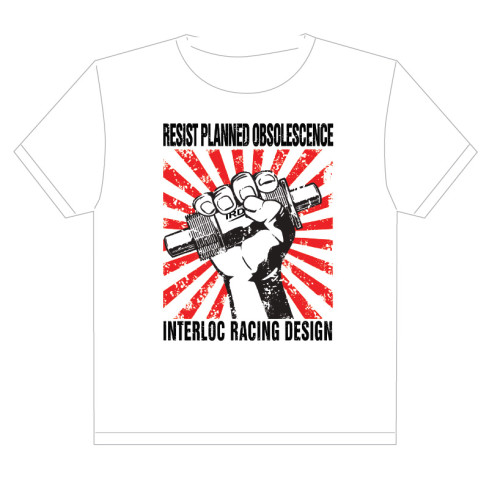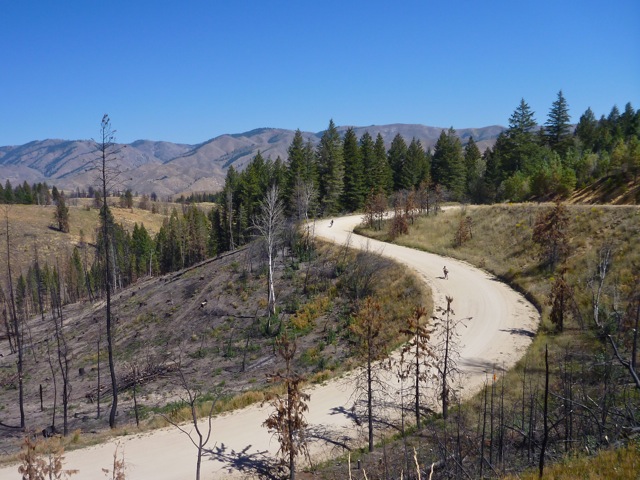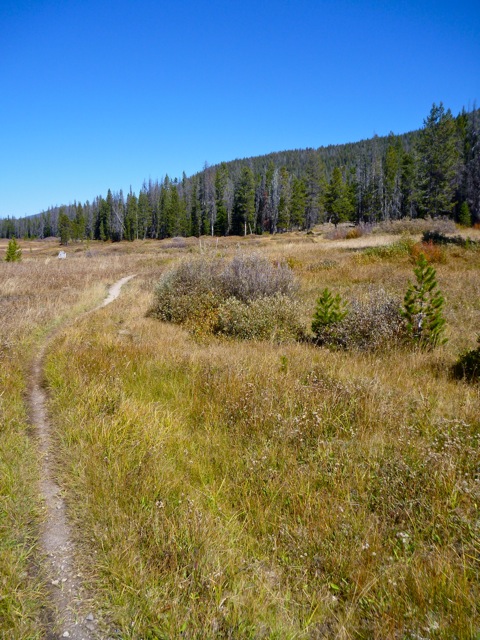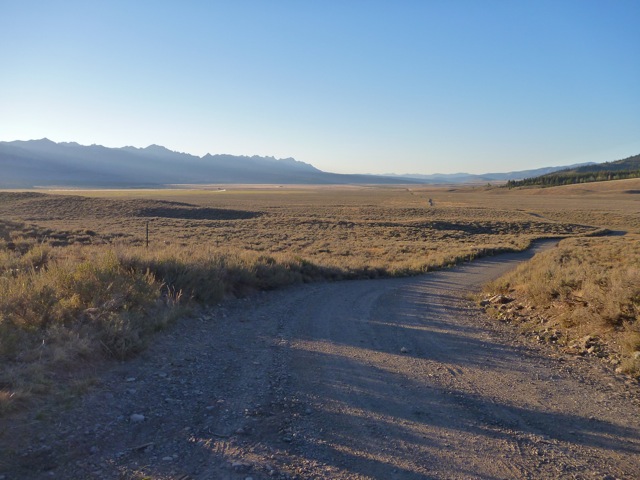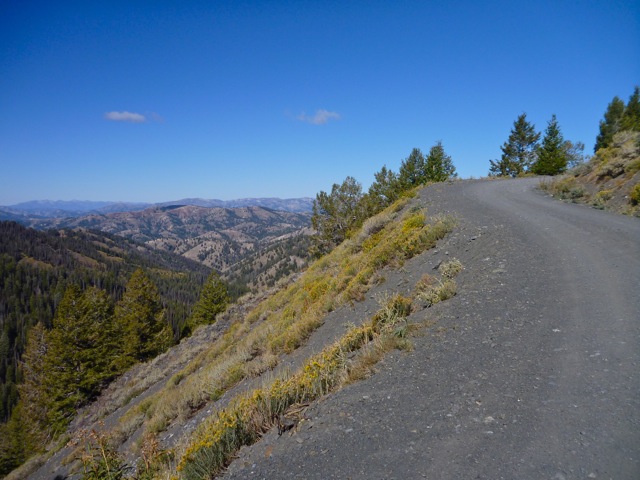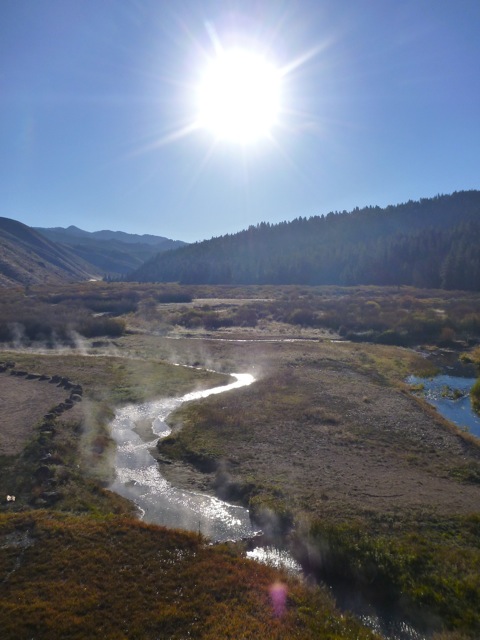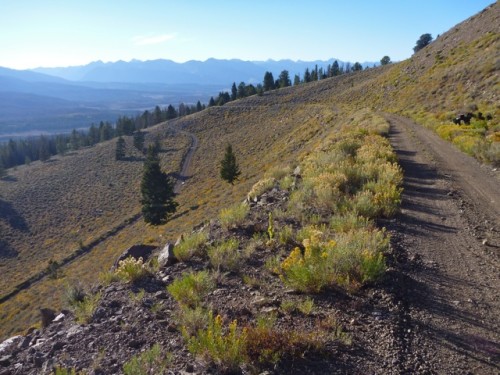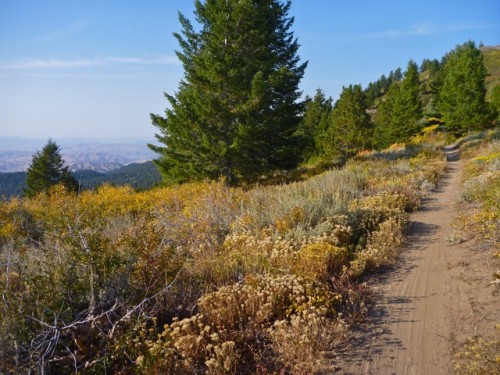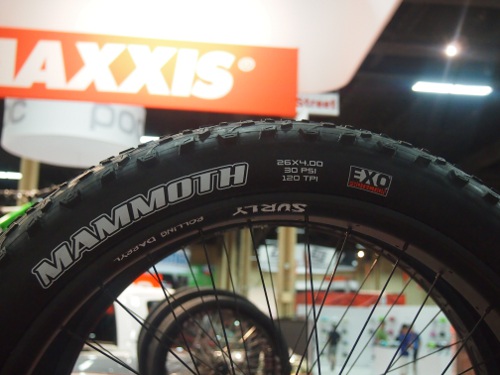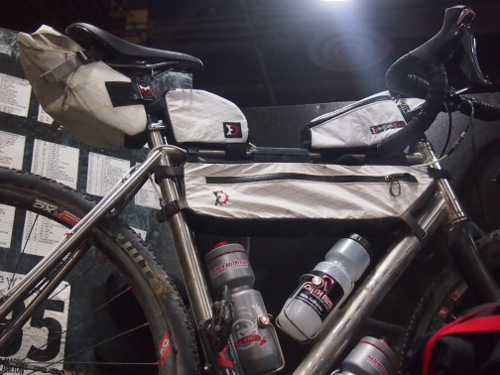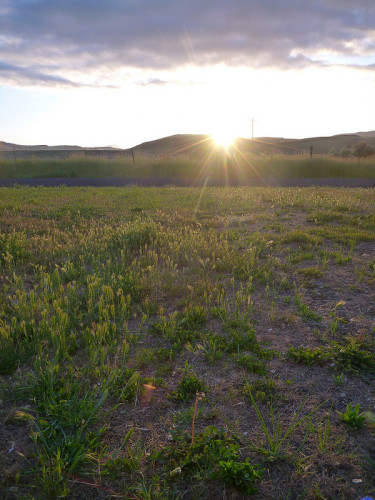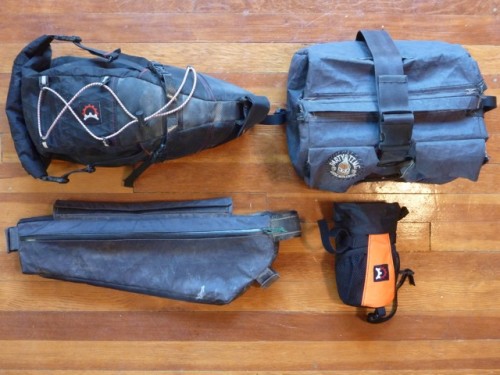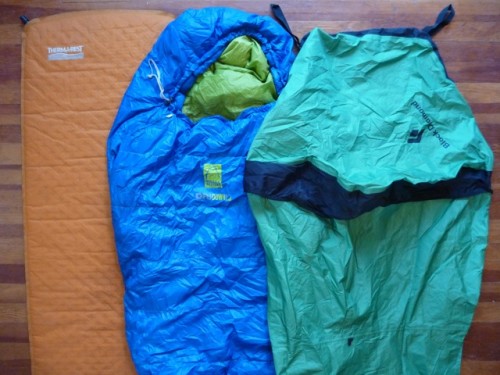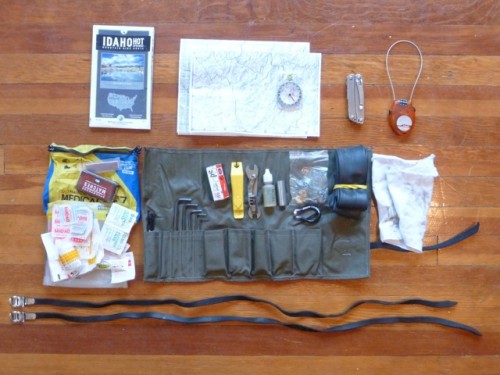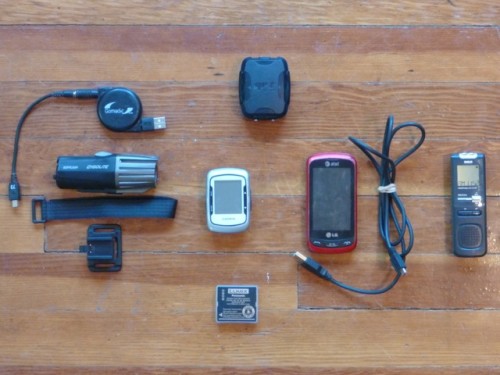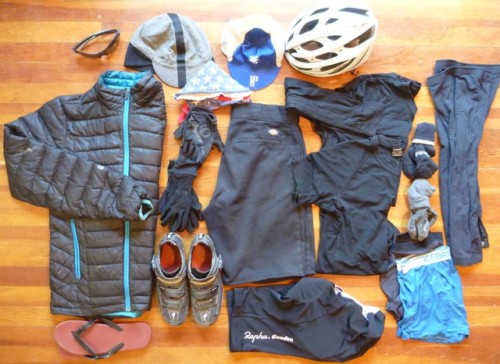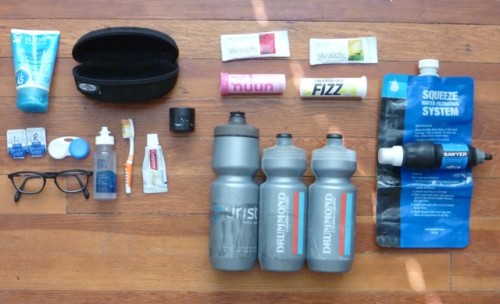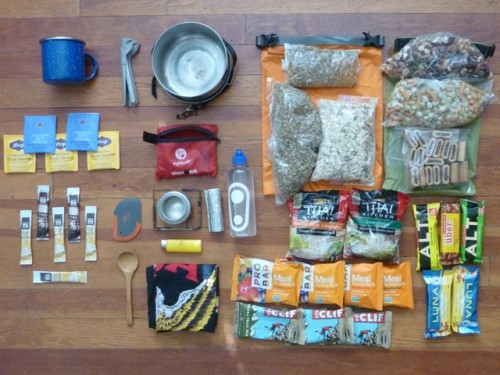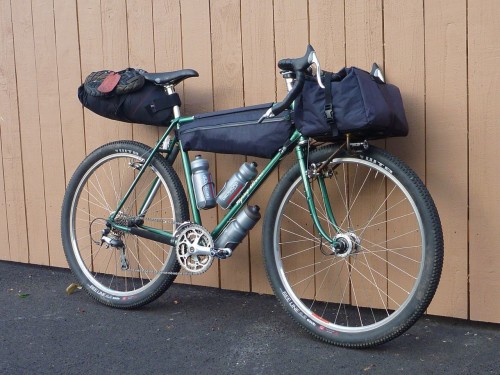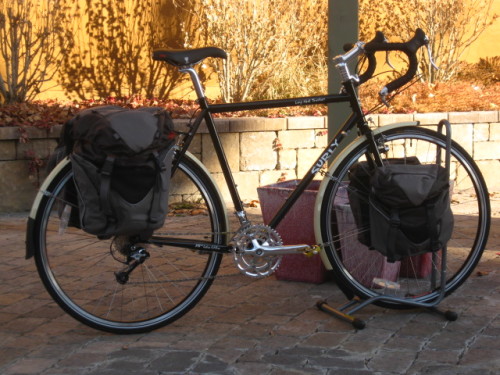 Today a customer brought his bike in and purchased a rack which the Bike Hermit installed- without charging for his time. On Saturday last, he installed a rack and new grips and frame bags on a customer’s bike. The bike and all the parts had belonged to Bike Touring News just hours before. Is that exceptional- or not even average- customer service, the Bike Hermit wonders. While visiting in Danville, CA a few years ago the Bike Hermit happened to be in a bike shop when a customer was consummating his purchase for what appeared to be a not inexpensive road bike. Part of his purchase was new road bike shoes. When he was asked by the customer how the cleats on his new shoes should be installed, the cashier person didn’t even budge from his stool as he told the customer basically to figure it out. That appears to be piss poor customer service.
Today a customer brought his bike in and purchased a rack which the Bike Hermit installed- without charging for his time. On Saturday last, he installed a rack and new grips and frame bags on a customer’s bike. The bike and all the parts had belonged to Bike Touring News just hours before. Is that exceptional- or not even average- customer service, the Bike Hermit wonders. While visiting in Danville, CA a few years ago the Bike Hermit happened to be in a bike shop when a customer was consummating his purchase for what appeared to be a not inexpensive road bike. Part of his purchase was new road bike shoes. When he was asked by the customer how the cleats on his new shoes should be installed, the cashier person didn’t even budge from his stool as he told the customer basically to figure it out. That appears to be piss poor customer service.
From a strictly business view we should probably figure out how long each widget takes to install and charge accordingly. Maybe the Bike Hermit is the slowest bike mechanic in the world but if he charged for the time he spent installing fenders- for the most flagrant example- the labor charge would far exceed the cost of the fenders.
Working on bikes is something he would almost do for free, wait a minute……he does do it for free. Sky King and the Bike Hermit would, and do, talk about bikes and bike touring for free too. As a business model, we probably won’t be on Shark Tank soon, but as long as we can spend January in West Texas, this is the best job ever!
Month: September 2014
We are always looking, hoping and striving for the best possible experience when we head out on a bike trip. Our free time to dedicate to these journeys is limited and valuable and we should do everything in our power to make the most of the opportunity. Many components in this alchemical equation are beyond our control. Weather, terrain, wild animals and innumerable other factors will all have a say in what we have to cope with out on the trail. We can try to plan and prepare for some of these unknowns but they are beyond our influence.
However, there are also key ingredients in an enjoyable bike trip that are wholly up to us. Our planning, preparation and packing all have the potential to make or break a trip. In hopes of improving our experience the next time, we look back upon returning to see what lessons can be learned. How did your planning, preparation and packing work out? What worked and what didn’t? What would you do differently next time? As you unpack, you have the opportunity to take a second look and assess your approach. Is there anything buried in the bottom of your bags that you had forgotten was there? Do you still have two pounds of food left over? By paying attention to these things during and after your trip, you’ll be able to learn from your mistakes and keep from repeating them in the future.
So, in hopes of offering some insight into this process, I’ll go through my unpacking and look back on the recent Smoke ‘n’ Fire 400. In doing so, I hope other new bikepackers and tourists will learn from my successes and failures so they can make their own mistakes rather than repeating mine! You may remember my Packing List and Planning posts on this blog. If you haven’t seen those I’d go back through them for the relevant background information.
Planning:
Overall, I’m pretty happy with my approach to the route. Given my lack of fitness and unfamiliarity with most of the terrain, I was well aware that any major setback could easily put me into a position where I would need an extra day to complete the route. So, I set out on Wednesday morning hoping to finish the ride before dark on Saturday but prepared to be out another night and finish on Sunday if needed. However, things went well out there and I was able to make it back to Boise’s Hyde Park neighborhood just before 7:00pm on Saturday. I was a bit disappointed to miss happy hour but the post-ride beer tasted just as sweet.
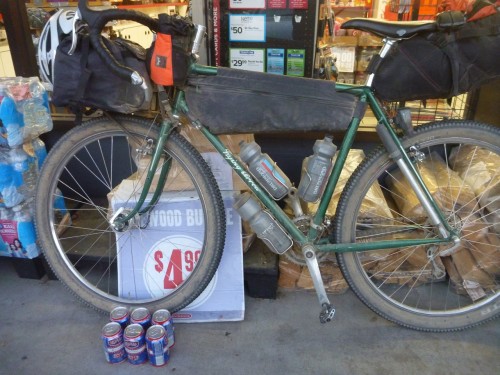
My daily distance goals proved to be attainable, though perhaps more difficult to reach than I expected. I’ll also admit to underestimating the amount of time the tougher climbs would require and the physical toll they would take. When planning, it is easy to be overly optimistic and forget how grueling long climbs can be on a loaded bike and I fell into that trap. Because of my lack of respect for the climbs – especially the grind up to the Dollarhide summit – I fell short of my goal to reach Redfish Lake on the second night. Looking back, I made the right call to stop and bed down rather than push on longer into the night. I made up the difference the next day over more level terrain and made it to Deadwood Reservoir on night 3 with daylight to spare.
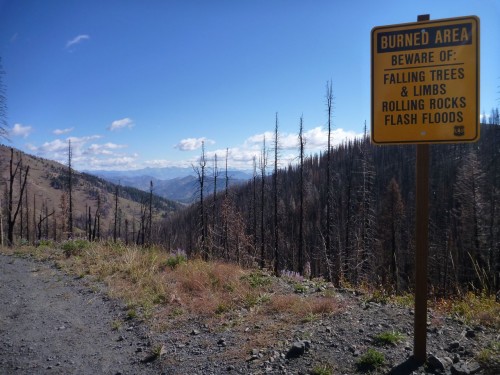
On a navigational side note, I did have some difficulties with my Garmin. I don’t know if other riders had similar experiences with their GPS equipment but my Edge 500 seemed to be struggling to communicate with its satellite and was very slow to update my position. Not a lot of satellites over Idaho, perhaps? I wasted a good deal of time standing still, waiting for it to re-find the route after going off-course. I was glad to have the Garmin but learned to keep the cue sheet handy to avoid missing turns. A handlebar bag with a map case is an ideal place to carry a map or cues and I’d like to experiment with different front carrying setups on future rides. Storing it under the strap on my handlebar bag works but is far from ideal.
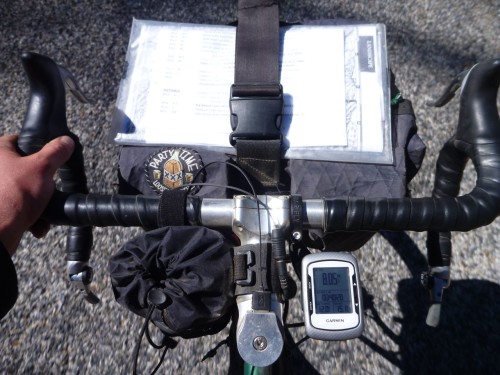
Also, I was very happy with the Revelate Feed Bag and found it to be a perfect addition to my cockpit. The ease of access to my trail mix and other snacks was excellent and allowed me to keep a constant flow of food coming in. The outer mesh pockets also provided a perfect place to stuff energy bars, empty wrappers, my audio recorder and other small objects that I wanted to keep close at hand. The attachment was simple and secure, though the stabilizer strap that loops under the fork crown was just barely long enough for my bike. Riders on more modern mountain bikes with tall forks and short head tubes won’t have problems but folks with high handlebars and non-suspension corrected front ends may have to improvise an extension to the strap.
Preparation:
I was not in the best of shape coming into this event. Other than quick rips on the mountain bike up in the Boise foothills and riding to get around town, I haven’t been on the bike much since returning from my short trip on the Hot Springs route back in July. Given that less than three weeks intervened between my hearing of the event and taking the start on September 10, there really wasn’t time for training. Mostly, I just focused on sleeping well, getting quality food in me and drinking enough water. Given that I much prefer hoppy beverages to plain water, this can be a challenge! I was certainly well-rested and had the leftover base from my other long rides this summer to get through the Smoke ‘n’ Fire but suffered more than I would have liked. I made up for my lack of fitness with experience and a conservative approach to the event. I knew I couldn’t afford to take big risks.
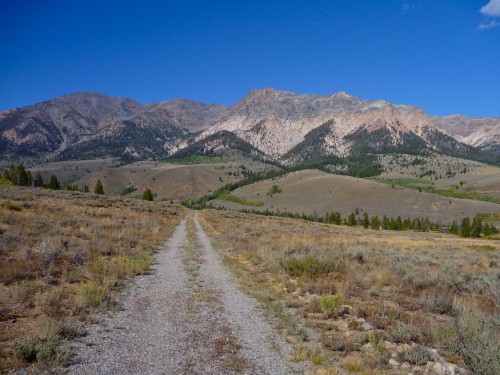
Overall, I measured my efforts well, stayed within my limits and got through each day’s ride about as well as I could expect. I only had one cramp (while putting socks on in my bivy), consistently ate and digested well and only had a small handful of nagging aches and pains beyond the normal soreness and fatigue. I had some pain in my achilles tendons, usually a symptom of a too-high saddle. I dropped it 2-3mm on the second day and things improved a bit. I also had some minor saddle sores and chafing. This could also be attributed to the too-high saddle forcing me to rock my hips on the seat. This point illustrates the need to put in plenty of pre-trip miles on the bike you’ll be touring or bikepacking on. Had I been riding the RandoGnar and not my mountain bike for the weeks before the race I would have discovered the saddle issue beforehand and corrected it before it caused issues.
On a related bike-preparation note, this ride certainly pushed the limits of singletrack riding that I would knowingly undertake with my current handlebar configuration. I love all the hand and body positions that my long-reach, deep-drop handlebars offer on easier terrain but they place me at a disadvantage when things get steep, rough or technical. For future trips with more singletrack riding, I’d switch to a more upright handlebar configuration. Something like the Jones H-Bars might be ideal as they offer a wide range of hand and body positions and would put me in a stronger position to attack difficult terrain.
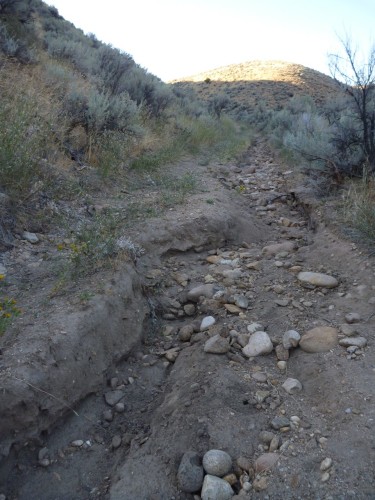
Packing:
It is easy to nerd out over this department. Sure, there are map nerds and fitness nerds out there too with their own brand of dorkery but nobody nerds out like gear nerds. You know the signs. You’ve seen the shelves and closets overflowing with x-pac, down, silnylon, titanium and carbon fiber. I’m talking about computerized spreadsheets with a few-thousand bucks worth of outdoor gear and bike parts all described, tagged, weighed, starred, “faved” and color-coded. And of course, everyone’s favorite obsession – light weight – is actually kind of a big deal when you’re talking about pedaling the whole mess up and down mountains for a few days. However, any factor in your planning, preparation or packing stands to wreck your trip if you screw it up – no one more than the others – so don’t forget to do your due diligence in other areas. Don’t let the gear get in the way of the experience.
I try to choose gear that is space-efficient and functional and try not to obsess about the weight. I can’t afford to re-outfit myself with the ideal kit for every trip so I’d rather purchase gear that is versatile and durable. For the most part, I think I packed well. I used every piece of gear I carried except for the ones I always hope not to use: tools and first aid.
However, the colder-than-expected temperatures in the low twenties (one night set a record low near Stanley) certainly pushed the limits of my equipment. If I had gone any lighter on shelter or clothing I could have easily gotten dangerously cold. I had a tough time keeping warm through my second-night bivy at the bottom of the Williams Creek Trail, high up in the Wood River Valley.
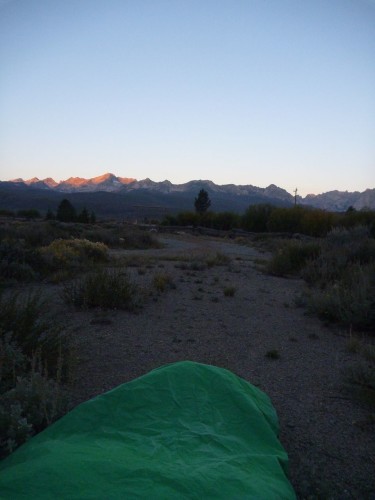
The frigid air seemed to sneak in through imaginary drafts in my bivy and sleeping bag though both were zipped and cinched tight except for a small breathing vent to prevent buildup of condensation inside the bivy. My feet suffered the worst of it. They were just starting to warm up and come back to life after some jumping jacks until I got back on the bike. The icy wind pierced my meshy shoes like needles. I improvised toe covers from a pair of ProBar wrappers (inserted over my socks, inside the shoes) which helped cut the chill and retain some heat.
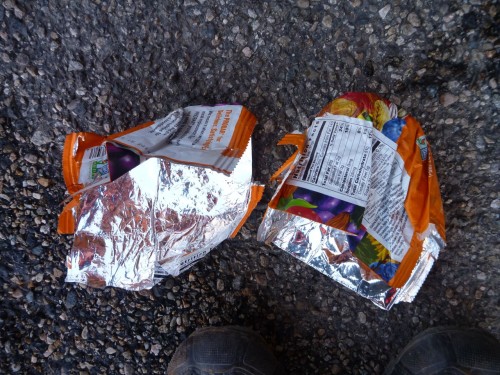
More substantial gloves, toe covers and/or chemical warmers in my shoes would have made the chilly mornings much less painful. Also, despite the lack of extra space in my bivy, I’ll be sleeping with my shoes on future trips where lows are expected to be below freezing. All the icy metal, plastic and carbon fiber in the soles of my shoes sucked the heat out of my feet faster than my blood could circulate.
Food-wise, I was pretty happy with what I carried and how much. I made one resupply stop in Stanley where I purchased some additional ride food (beef jerky, Baby Ruth, Snickers, Mr. Goodbar, two bananas) and supplements (pouch of chunk chicken, Ramen noodles) for my final dinner on the trail.
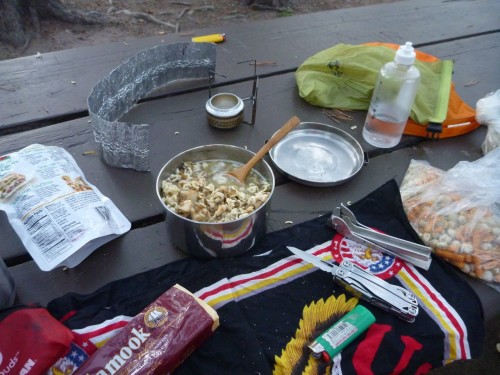
I stopped at some of the convenience/general stores along the way when they were available for cold drinks and to refill water. I also enjoyed a beverage stop with some new friends at the Featherville Saloon on day 1 and an amazing breakfast on the morning of day 3 at the Redfish Lake Lodge.
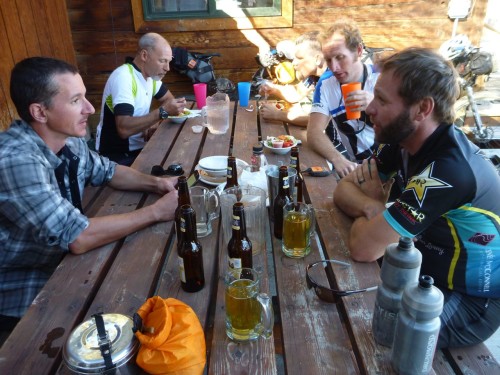
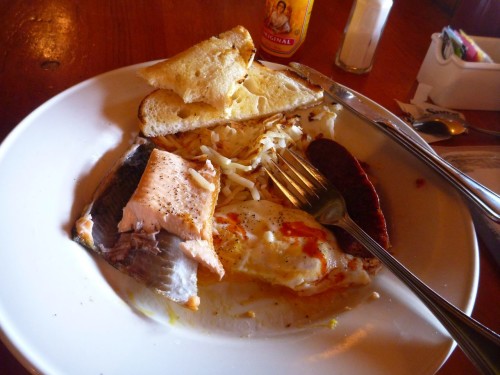
Aside from these little luxuries, I ate and drank only what I carried and was able to ride safe in the knowledge that I had plenty of calories on board, could filter water from any of the many streams on the route and cook up a hot meal whenever appropriate. Conversely, with good route and resupply information, proper planning and measured riding, one could tackle this route (as many did) with a bare minimum of food on the bike, relying on services in towns and outposts along the way. Although a more expensive way to travel, this tactic certainly has its benefits as food gets heavy fast. It would have been easy to drop several pounds of weight off my bike by leaving the cookset and camp food at home but I would have had to sacrifice a good deal of my self-sufficiency and independence. For my purposes, it wasn’t worth it.
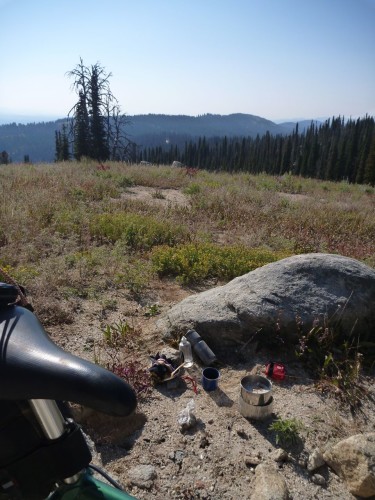
I rode into the darkness on both of the first two nights and found my lighting setup to be nearly ideal. The combination of the dynamo-powered headlight fixed to my front rack and the USB-rechargeable lamp on my helmet worked well in a variety of conditions. I could use the low, wide, bright beam cast by the dynamo light for most roads and supplement that light with the headlamp’s powerful spot for singletrack or whenever a more precisely-directed beam was needed.
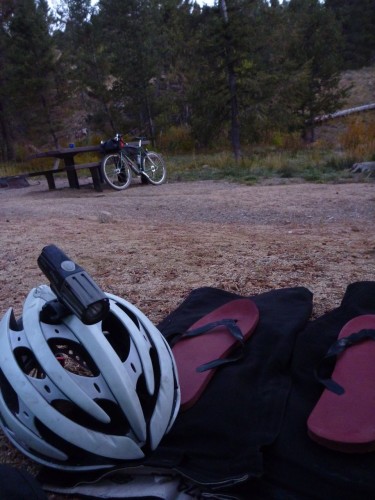
This system really proved itself on the second day. I had used the CygoLite for the last couple of hours on my first evening’s ride and continued to employ it while I cooked my dinner and made camp that night. I plugged it into the Sinewave Cycles Reactor as shadows began to grow long on the second day, got it topped back up to a full charge and used it for three or four solid hours on the second night to get me through the Fisher Creek/Williams Creek singletrack section under the light of the stars. This descent was one of the highlights of the trip and would not have been any fun at all with sub-par lighting.
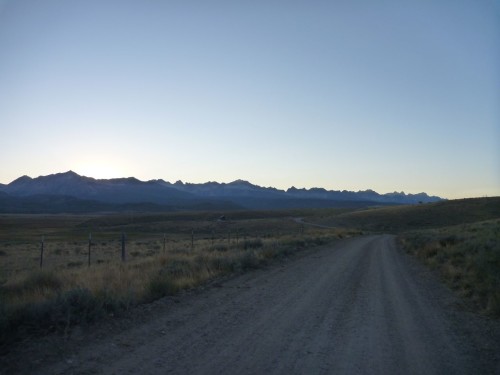
Looking back, it is hard to see this ride as anything other than a great success. Even so, I’m still looking forward to refining my approach to future rides and applying what I’ve learned. I hope these posts have been helpful and entertaining. Feel free to leave your questions and comments below. Thanks for reading!
So, what happened out there? Frankly, I’m not entirely sure. Even after nearly three days back at home and two glorious nights of sleep in my own bed I’m still sifting the ashes. All the oversaturated visions of rivers, mountains, valleys and canyons I had out there in the Idaho high country are swept into a continuous blurred mental replay that rolls to the soundtrack of fat tires rumbling over rock and gravel. I’ve been digging back through the artifacts – the empty wrappers and dirt-crusted bottles, the filthy clothes and foul-smelling socks, the crumpled maps and GPS tracks and the photographs and the journal entries – looking for answers. The excavation stirs the cooling embers of the fire that burned bright for four days but only a pale glow is left, barely visible in daylight. I can feel it in my still-tingling toes, swollen ankles and healing saddle sores. The photos are there, all 354 of them, but they don’t look quite like I remember them… There they are, the hot springs, the sheep herd, the hairpin turns, the bald eagle, the endless road. Depending on shutter speed, all of these photos account for somewhere around six seconds of total time over the course of 84 hours out there in Idaho. What happened in between?
For those on the outside of this event, Trackleaders’ ride tracking page offered a God’s-eye view of the action that feels something like a game of Pac-Man played in super-slow-motion. Through the miracles of satellite photographs and map overlays, the casual spectator had access to a wealth of information about the event as it unfolded in real time. Much like Santa Claus, they knew when we were sleeping, knew when we were awake and could probably make an educated judgement as to wether we were being bad or good. But while the race replay feature can show you who won and who slept and where we got lost, those little tracker pins racing around like deranged slot cars don’t really tell you much about what happens out there.
Despite all this recording of ones and zeros, there are massive gaps in the record: moments that went wholly undocumented or recorded in any way. These moments could hardly even be called memories as they were experienced in a state of no-mind.
After a couple of days, the routine of pedaling ones bike from sunup to sundown becomes natural. Time begins to distort. Sometimes hours fly by and you note the passage of time only when your shadow appears on the right rather than the left. Eventually – like a circumambulating pilgrim – we find a mental space in which we move through the landscape just as it moves through us, leaving only a faint track and puff of dust. A vague trace is all that is left of our passage, each through the other. No GPS data, no pixels or POIs on a map can tell those stories. The times of most complete focus make the greatest impact but leave us with only a vague notion of what happened, like a smeared painting or dream forgotten upon awakening.
So why do we go? What pulls us from of our comfortable lives out onto the trail where we are at the mercy of the elements and forces of nature that we could never understand?
Sometimes we need a challenge put to us. We need a test to pass, an opportunity to excel, to show our abilities and prove ourselves. Prove ourselves to who? Ourselves, mostly. To prove to ourselves that we can do bigger and better things that perhaps we ever thought we could.
Sometimes we need to escape. Escapism is a natural reaction to conditions that offend our spirits so we seek an escape into a simpler world to restore a sense of balance. Finding this balance point isn’t easy, however. Tip the scales too far and you might be gone for good.
Sometimes we’re chasing. We’re looking for something – we’re not sure what – that we lost along the way. Or we’re striving for a goal, driven on by the desire to acheive, conquer and win. Looking for one more fix, one more thrill.
No matter what drives us out into these places, out on our bikes over mountain passes and down harrowing descents, through darkness and blinding sun, frost and fire, we all end up finding something. It is different for all of us and that is what keeps us coming back. To get one more taste, to draw the cold, pre-dawn air into your lungs and feel it purify you as you round a bend on a high mountain pass. We go as explorers of the world within us and without us, to adjust our sense of scale and reckoning of our position. We go to be put in our place. To be awed and humbled by the majesty of the world outside the narrow tunnel we often see through.
We go to lose our minds, to find our no-mind, to forget everything except the essential: food, water, clothing, shelter and forward progress. Always forward. The mountains, rivers, pairies and gorges of central Idaho are the perfect place to outrun whatever chases us and find whatever we’re looking for. Out in this wide-open country there is room for us to grow and expand beyond the normal bounds that we exist in. The clear, blue air and cold, crystalline streams carry our hopes and dreams. We just have to carry enough food.
Upon returning, our charge is to carry the clarity of vision, simplicity of purpose and purity of drive found on the road into everyday life. This isn’t easy. Reintegration into a world that scarcely understands what we’ve lived through is not a simple matter. How does one explain the deeply-felt but inexplicable meaning of such a journey to friends, family or co-workers? To those who haven’t experienced something similar, it’s just a long bike ride and you’re just crazy for doing it. The truth is, they’re right on both counts. But there is more beneath the surface of a long bike ride.
To leave the lessons of the trail behind is to decline a great gift. Our daily lives can be hurried and complex, filled with a paralyzing array of choices or possibilities. With no cue sheet, route map or GPS track to guide us, we have to make our own way and find our own path. We must continue to seek moments of no-mind, break free of old patterns and habits that keep us trapped in a stable, predictable but ultimately unsatisfying existence. If we get it right, we’ll look at our familiar world through new eyes, see everything always for the first time, dream, chase and dream again.
>~\~>
See my pre-ride entries about packing and planning for the Smoke ‘n’ Fire 400.
Thanks for reading.
All photos ©Ryan King flickr.com/photos/rspinnakingAt the 2014 Interbike trade show, it seemed to us that 27.5″ (a 650b by any other name would ride as sweet), so called “29+” and fatbike tires are gaining traction with manufacturers and with consumers. As fans of the 29+ wheel/tire combo as on the Surly ECR we were excited about the number of upcoming offerings for tires and rims.
29+
Maxxis have 29 x 3″ tires coming out.
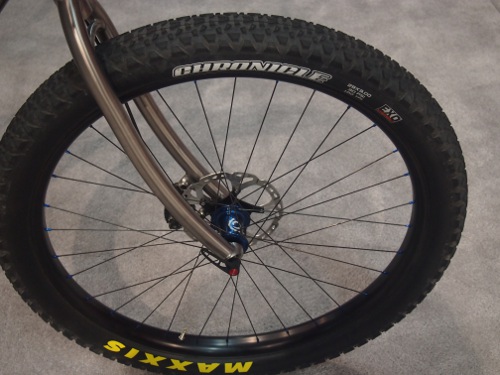
Stans NoTubes showed the Hugo 52 rim which is designed to work with tires such as the Surly Knard 29 x 3. (There will be 26″ and 27.5″ versions too) Generally, a non-tubeless-ready tire will not work well in a tubeless application even if the rim is made for tubeless. That is because the bead of a non-tubeless tire will not mate properly with the bead seat on a tubeless rim. But Stans designed the bead seat on this rim to work with non tubeless tires. They developed a sort of reverse box rim design so the profile from the outside is almost impossibly slim since the box section intrudes to the interior of the rim. In order to mount the tire, the rim needs to be basically inserted inside the tire cavity so that each tire bead is on the outside of the rim. Then each bead is worked over the rim from outside to inside.
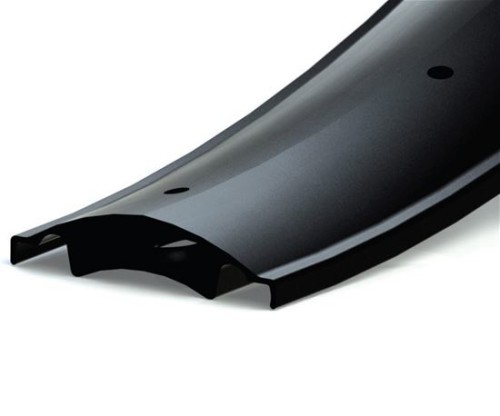
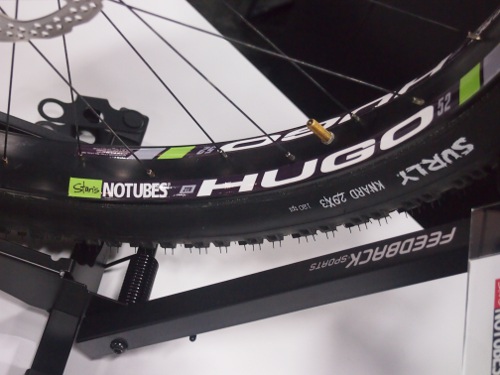

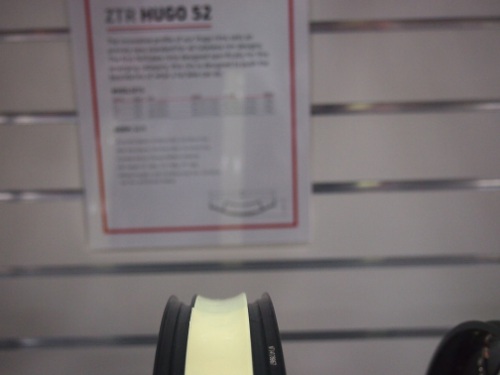
The Bike Hermit™ has been a curmudgeon when it comes to tubeless tires but with the lower pressures we have been running in the 29 x 3″ tires for desert touring he is pretty stoked about these tubeless rims because one of the main advantages of tubeless is the reduced chance of pinch flats when running low pressure tires (around 12 psi or so in the Knards).
FATBIKE TIRES
A couple monthe ago I asked my Schwalbe salesperson when he thought Schwalbe might make a fatbike tire. He said, basically- when they thought fatbikes had legs. Well, fatbikes got legs! Apparently:
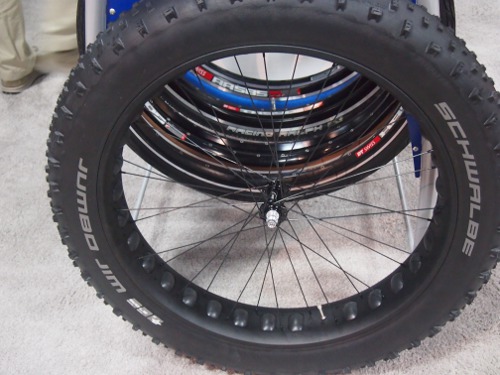
On Monday September 8 between 4 and 5 inches of rain fell in southern Nevada and wiped out portions of I-15, the main highway between Salt Lake City and Las Vegas, and resulted in the worst flooding in over 30 years in the area. We heard about it first from Eric Parsons who was having his booth for Interbike shipped to him from Salt Lake. He finally got it set up around six PM…after the first day of the show.
When we stopped by again on Thursday we had a chance to talk and to get updates on new stuff from Revelate Designs;
They have a prototype for a new Tangle Bag (the original will still be made) which addresses the stress on the zipper to the main compartment. Apparently that side is the one that is most abused with a loaded bag. The prototype (which is close to production) uses a flexible cover shield to keep out the elements and a non-waterproof zipper for durability. The final bag may incorporate a more flexible material on the top of the bag where it attaches to the top tube to further reduce stress on the zipper area.
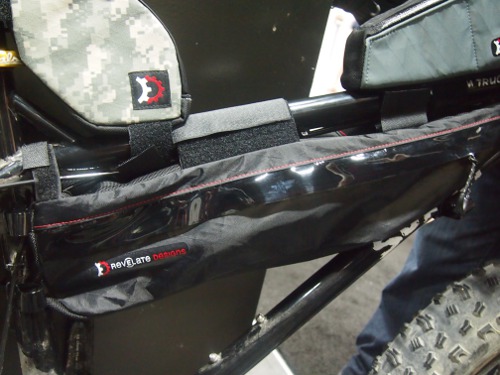
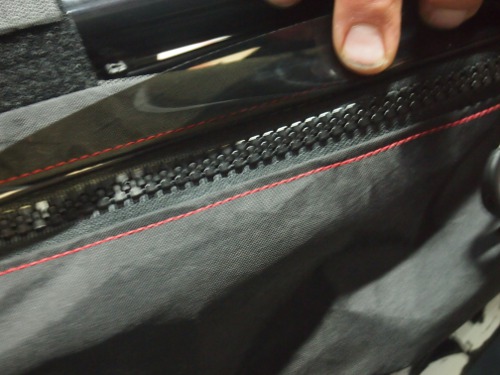
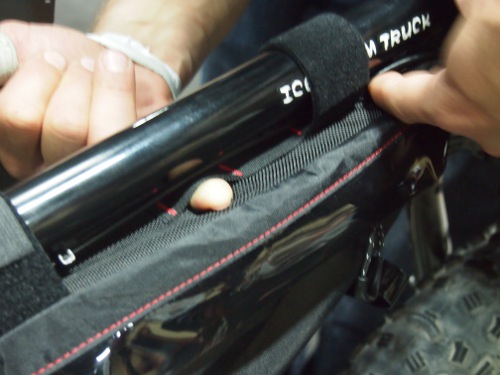
They still make some bags out of the super light Cuben Fibre material but it is so labor intensive that they don’t wholesale the bags yet. There is a mid weight material though that is very tough and durable and is a similar swanky looking white.
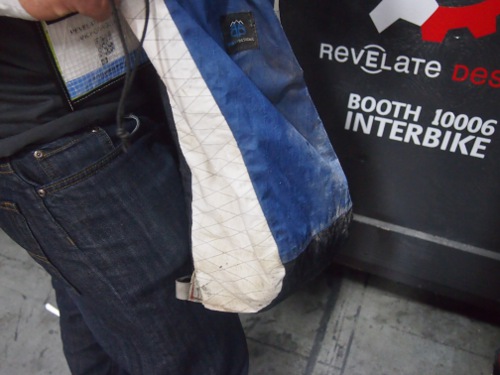
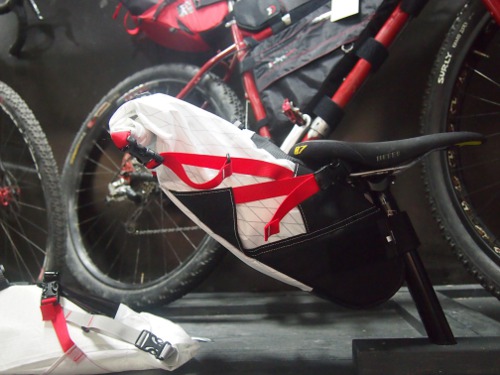
There is a newly designed Pocket as well. This one features a curved zipper which creates sort of a lid, the idea being that it will be easier to access while on the bike. The bag is also reinforced in a way that it retains its shape and there are attachments that will make the bag more stable when used as a standalone piece, without a Harness or Sweet Roll.
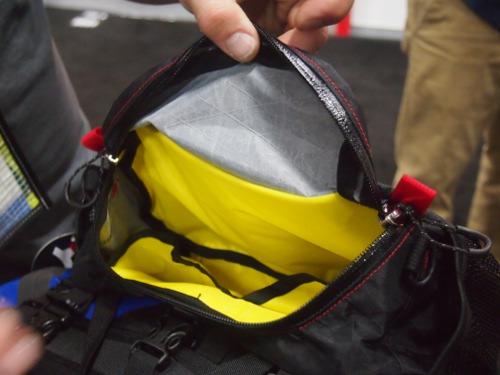

I’m glad we went back and had a chance to talk with the guys from Revelate Designs because, at first glance, there didn’t appear to be a lot that was new. But they are always thinking and tinkering and improving. We are looking forward to the next generations of bikepacking gear!
By the time you’ll be reading this post, I’ll be headed eastward out of Boise with thirty-some other weirdos on a counter-clockwise loop central Idaho known as the Smoke ‘n’ Fire 400. You’ve probably already seen all the stuff I’m carrying with me. Now I’d like to share some of my hopes, dreams and plans for the ride.
I’m not really sure what to expect from myself as this will be my first long-distance solo bikepacking trip. On previous trips I’ve traveled with friends, ridden fairly hard during the day but spent plenty of time relaxing in camp and hanging out along the way to enjoy shady spots, roadside bars, swimming holes, hot springs and other amusements. On this ride, I’ll be on my own, free to ride at my own pace and set my own agenda. I don’t intend to ride so fast, hard and long that I miss all the grandeur around me and neglect opportunities to enjoy my surroundings. There is more to be gained from this event than simply posting a fast time. I don’t do these kinds of rides to set records but rather to explore the world within and without me, to push my own limits and see what lies around the next bend. I’m especially excited to have another opportunity to see more of my new home state and lay the groundwork for more Idaho adventures.
Given that my fitness has declined somewhat from the midpoint of summer, I’m trying to be cautiously optimistic in my planning for this trip. The route totals almost precisely 400 miles and roughly 33,500 feet of climbing. The distance is roughly the same but elevation total is more than twice that of the Oregon Outback and I spent a solid four days on that route. However, during those four days I spent more time standing still than moving. This ride will give me a chance to see what happens if I invert that balance and spend as much time as possible in motion without sacrificing the quality of my experience. Perhaps you share a similar curiosity and wonder what you might be capable of outside the boundaries and restrictions you find yourself constrained by.
So, my optimistic plan is to finish in four days, averaging 100 miles per day and arriving back in Boise late on Saturday. This is achievable if things go well and I have very few navigation, physical or mechanical problems but would be a seriously big ask given my relative lack of fitness and experience in these events.
Reference this route map from RideWithGPS to follow along.
The itinerary for the four-day plan would look something like this:
- Boise to Five Points campground
- Five Points to Redfish Lake
- Redfish to Deadwood Reservoir
- Deadwood to Boise
The more conservative plan is to finish in five days, averaging 80 miles per day and getting home sometime on Sunday. Given the freedom and flexibility I’ll have to keep pedaling, I’ll hope to do better than this but won’t be disappointed if circumstances conspire against me.
The five-day itinerary would be roughly:
- Boise to Featherville
- Featherville to North Fork campground
- North Fork to Redfish Lake
- Redfish to Deadwood Reservoir
- Deadwood to Boise
Overall, I’m thrilled to have this chance to see some new parts of Idaho while exploring the edges of my ability as a rider. I hope you’ll follow my progress and that of my fellow participants via the Trackleaders race tracking page. I’ll also be tweeting from the field where possible. Follow me @rspinnaking. I’ll be using the hashtag #snf400.
After the ride is over, look to this blog for stories of success and failure, beauty and desolation, life and death from the first running of the Smoke ‘n’ Fire 400.
Thanks for reading.
Greetings! I’m a new voice here so I’ll briefly introduce myself. My name is Ryan King and I’ll be riding the inaugural Smoke ‘n’ Fire 400 bikepacking race with the support of the good folks at Bike Touring News. I’ve done a small handful of rides like this, including the Oregon Outback in May of this year and a four-day trip on the Idaho Hot Springs Mountain Bike Route in July but this will be my first solo, race-type bikepacking trip. I’ve always sought out new ways to push my limits as a rider and am excited (and a little nervous) about seeing what I’m capable of through this test. As a first-time “racer” I’m no expert at any of this so I hope that I can offer some insight into my approach to this event and help others learn from my successes and mistakes while encouraging them to undertake similar challenges of their own.
Bicycle travel can be as simple or complex as you want to make it. I think this is part of why I enjoy a bikepacking-style approach and make every effort to streamline and simplify my trip rather than finding ways to bring more and more gear. This takes a good deal of planning and head-scratching sometimes but the joyful freedom of pedaling a bike packed with everything you need and nothing you don’t is well worth the extra work ahead of time.
So, let’s get down to the nitty-gritty. What do you bring on such a journey and how do you carry it? Let’s start with the “how” and then get into the “what” after that.
Luggage
For me, the first decision isn’t so much what to pack as how to carry it. The carrying capacity offered by traditional rack-and-pannier setups is appealing (and ideal for longer trips) but their bulk makes them impractical when one intends to travel light and fast over more rugged terrain. The benefits of bikepacking-style luggage have been extolled elsewhere but the main advantages for my purposes are lighter overall weight, improved aerodynamics and more clearance on narrow trails or when pushing the bike.
My setup differs slightly from the “standard” bikepacking kit in a couple of ways. First, I prefer not to carry a backpack or hydration pack so I use a half-frame bag that fits under the top tube with room for water bottles in their cages. The frame bag does fit a 100 oz. hydration bladder to stretch my water-carrying ability when needed. Also, my bike is built around drop bars and a medium-size front rack, so I use a rack mounted handlebar bag rather than a handlebar harness. This allows me to carry odd shaped, non-compressible items and offers fairly easy access to all of the bag’s contents without having to unpack. For routes consisting of roads and easy singletrack, I find this setup to be ideal.
Although it can create something of a packing nightmare when trying to find space for everything, I find it important to place constraints on the amount of gear I’m able to carry by not allowing myself a place to put it. This forces a higher level of planning and prioritization that pays off if done right. Of course, there are potentially serious consequences to leaving a key piece of gear at home but experience and research will be your guide when it comes to what really matters. Overall, a lighter bike is more fun to ride, you’ll get up the climbs with greater ease, cover rough terrain more easily and be able to enjoy your time in the saddle much more. If your trip involves more time spent in camp than on the bike, you’ll want to pack very differently.
Here’s my luggage for the Smoke ‘n’ Fire:
- Revelate Viscacha Seat Pack
- DIY Handlebar Bag
- DIY Half-Frame Bag
- Revelate Feed Bag
Sleep Kit
This is one department where opinions are as varied as the riders espousing them. Some will sleep very little or plan to use lodging along the route, carrying only the bare minimum for survival if forced to camp. Others will carry a full-size tent, air mattress and perhaps even a camp chair. Others prefer a hammock rather than sleeping on the ground. In wet climates a synthetic-fill bag may outperform down which loses its loft when wet. As outdoor gear gets lighter and more packable, there are lots of good options for bikepacking-friendly gear in this department if you have the coin to spend. My low-budget approach forces some compromise and I carry more weight and bulk in sleep kit than I would prefer but I know I’ll stay dry and warm in anything but full-on winter conditions.
- Therma-Rest Prolite 3 Sleeping Pad, Small
- Sierra Designs Zissou 23° Sleeping Bag, 700-fill “Dri-Down”
- Black Diamond (Bibler) Bipod Bivy w/single pole and 4 stakes
Tools, Spares, First Aid
One of the great joys of traveling by bike is its efficiency. On a bicycle you have ability to cover an immense amount of distance each day, even over terrain that would stop a four-wheel-drive truck in its tracks. However, one mechanical issue at the wrong time will turn your amazing machine into a glorified luggage cart. If you don’t like the idea of pushing or dragging your bike for miles on end it is critical to carry the tools needed to fix common mechanicals and know how to use them. Most modern bikes require only a handful of hex wrenches to perform the majority of adjustments or repairs you’d need to make on the road. Don’t go off the deep end preparing for every potential catastrophe and weigh yourself down with several pounds of hardened steel that you’ll never use. If you maintain and service your bike before your trip, you shouldn’t have to perform major repairs in the field. There also comes a point where you have to place your trust in your equipment and hope for the best. Your tool needs will vary depending on your bike and route but my tool roll holds pretty much the same kit I would take on a long day ride with the addition of a few “just in case” items.
My first-aid kit looks small by comparison but I tend to ride very carefully on trips like this and rarely suffer much more than the odd abrasion. The Smoke ‘n’ Fire route is never too far from major roads or outposts of civilization, so I’ll rely on outside medical aid in case of anything more severe.
I plan to use my GPS unit and cue sheet for primary navigation but always like to have good old paper maps as a backup. I don’t like to place too much trust in electronics.
- Idaho Hot Springs MTB Route Map (shows 90% of Smoke ‘n’ Fire route)
- Relevant photocopied map pages from Benchmark’s Idaho Road and Recreation Atlas
- Compass
- Leatherman Wingman multi-plier
- Bakoda Cable Lock (for a little peace of mind when making resupply stops)
- First Aid Kit w/ alcohol swabs, misc. bandages, anti-chafe cream, moleskin patches, waterproof matches.
- DIY Tool Roll with 6, 5, 4, 3, 2mm hex wrenches, vulcanizing patches and glue, 9 and 10-spd quick-links, tire lever, DIY multitool with chain tool, 8, 9, 10mm open wrenches and bottle opener, chain lube, duct tape, spare Crank Bros cleat, misc. spare hardware, spoke wrench, tube, rag.
- DIY leather “Junk Straps”
- Not Pictured: Topeak Road Master Blaster frame pump (on bike)
Electronics
The escape from our screen-filled, flickering electronic world of ones and zeros is an appealing feature of these kinds of rides. They allow you an opportunity to get back to a more immediate, unplugged, unfiltered, simplified existence. This is why I carry a minimum of electronic distractions. I brought an iPod on the Oregon Outback thinking I might need the music for extra motivation but never used it. I’m constantly shocked and amazed by the desire people have to carry all the mess and noise of the modern world with them into the backcountry. However, I do appreciate GPS technology for simple route-following and ride tracking, love my digital camera and struggle to imagine a world before high-powered LED lighting. The lynchpin of this setup is the dynamo hub on my bike which powers my main headlight and a USB charger that allows me to recharge most of my devices on the go.
- Cygolite Expilion 700 USB-rechargable headlamp w/helmet mount
- Garmin Edge 500
- Gomadic Charging Cable (specific to Edge 500, also charges the Cygolite)
- SPOT Tracker
- Cell Phone & Charging Cable
- Digital Voice Recorder (easier than a paper journal for ride notes)
- Spare Battery for Panasonic Lumix DMC-TS2 (Camera not pictured. Guess why.)
- On Bike, Not Pictured: Supernova E3 Pro Headlamp and Sinewave Cycles Reactor USB Charger, powered by Shimano DH-3N80 generator hub. Portland Design Works Radbot Taillight
Clothing
Similar to tools and spares, this is another department where it is easy to overpack in a vain attempt to be prepared for anything. In my estimation, if there isn’t a time where I’m wearing nearly every article of clothing I packed, I brought too much. I’ve fallen in love with wool shirts as opposed to the wicking synthetics typically used in technical clothing. They seem to hold just enough sweat or water next to my skin to allow it to cool me off when hot and never feel chilly or clammy when cold. For a trip like this where I don’t plan to spend much time in towns or in camp I don’t bring changes of clothes. I’ll be stinking to high heaven after a few days but bringing extra clothes just for the luxury of feeling a little more “civilized” isn’t worth it to me. However, with early morning temperatures expected to be below freezing in the high places I want to give myself the best chance of staying warm.
- Smith Pivlock v90 sunglasses, platinum lens
- Wool cycling cap w/earflaps
- Generic cotton cycling cap
- Lazer Genesis helmet
- Sierra Designs Gnar Lite down jacket
- Pearl Izumi cut-off half-finger gloves
- Seirus softshell long-finger gloves
- Dickies cut-off shorts
- Icebreaker wool long-sleeve
- Icebreaker wool short-sleeve
- Wool socks, thin
- Wool socks, thick
- Leg Warmers
- Synthetic (quick drying) underwear for hot spring or river dips
- Icebreaker wool underwear
- Rapha bibshorts
- Specialized Pro MTB shoes
- Cheap flip-flops
- Not Pictured: Giro Insulated Vest
Hygiene and Hydration
I tend to keep things pretty simple here as well, especially for short trips like this. I find some kind of electrolyte supplement to be a big help for warding off cramps. I also get tired of plain water and like having one bottle of water and one of some kind of drink mix on the bike at all times, mixing up the flavors for some variety. It’s easy to get sick of a particular taste when you’re sucking it down hour after hour, day after day.
For a trip this short, I’ll make do with quick stream baths to get the worst of dust and dirt off but would never go without my toothbrush! However, I will use alcohol wipes in my first-aid kit to keep my backside clean. The last thing I want to deal with is an infected saddle sore.
- Sunscreen
- Hardshell sunglass case for glasses and toiletries
- Spare contact lenses
- Lens Case
- Contact Solution
- Glasses
- Toothbrush
- Toothpaste
- Chamois cream
- Skratch Labs drink mixes
- Nuun electrolyte tablets
- Hammer Fizz electrolyte tablets
- Sawyer Squeeze water filter and bag
- Water Bottles, two 22 oz., one 26 oz.
Cooking and Nutrition
This is one area that I tend to overprepare in. In an ideal world, I would carry just enough food to get me to my next resupply location without going hungry. In the real world, I’d always rather have a little extra. I also never know what I might find at unfamiliar stores so I prefer to carry a larger supply of food that I know packs well and keeps my fire fueled rather than making do with whatever I can get my hands on. Also, this prevents me from being at the mercy of small country markets that often have irregular and unpredictable business hours. There is comfort in the knowledge that if shit hits the fan I won’t be going hungry.
For rides like the Smoke ‘n’ Fire, some light-and-fast purists will leave the cookset at home. For me, the comforting, morale-boosting ritual of preparing and enjoying a warm meal or hot beverage is well worth the extra gear and preparation time. I prefer to cook simple dehydrated meals where I can just boil a small pot of water and add food. This allows me to carry my simple, compact and lightweight alcohol stove. There are lots of dehydrated food options at grocery stores with well-stocked bulk departments in addition to the freeze-dried meals available at outdoor stores. Typically, I’ll carry oatmeal with dried fruit, granola or trail mix for breakfast and some kind of soup or bean mix for dinner. I’ll supplement these bases with whatever I pick up along the way. Jerky, smoked fish, tuna packets, summer sausage and cheese are favorites for quick protein and require no additional cooking. I’ll also try to pick up fresh fruit where possible and eat it immediately since it doesn’t pack well. When time and funding allows, a break for a hot meal in town is always a morale booster and gives me a chance to take on extra calories that I don’t have to carry.
On the bike, I’ll eat just about anything. I like prepackaged food bars for ease of carrying/consumption, calorie density and variety of flavors/nutrients. ProBars are among my favorites and I rarely get tired of them. I’m excited to try out Revelate’s handlebar-mounted feedbag on this trip as it will allow me to have a bag of trail mix or other snacks easily accessible for one-hand munching. In the past, I’ve finished trips with huge quantities of trail mix left over because it is so difficult to eat while riding and I’m typically eating my breakfast or dinner if I’m in camp.
For many of us, a hot cup of coffee in the morning is not a luxury but a necessity. However, coffee beans and the apparatus needed to prepare them can be difficult to justify carrying and create additional waste that must be dealt with in a responsible way. Fortunately, Starbuck’s VIA or Mount Hagen instant coffee packets are a workable substitute. I’d much rather drink VIA than actual Starbuck’s coffee; at least it isn’t burned yet. I also enjoy a warm cup of caffeine-free tea in the evenings while taking in the stars. Lemon ginger tea with a splash of whiskey is a pretty delightful nightcap!
- Enameled Cup
- Pot Gripper
- MSR 1-liter stainless steel pot w/lid
- 1 cup Refried Bean mix
- 3 cups Lentil Soup mix
- 4 cups Oatmeal w/dried mixed fruit
- 2 Thai Noodle Soup packets
- Trail Mix
- Sesame Cheddar Sticks and Wasabi Peas
- Fig Bars
- 12 assorted Energy Bars
- Handkerchief
- Bamboo Spoon
- Pot Scraper
- DIY Beer Can Alcohol Stove
- DIY Bicycle Spoke Pot Stand
- DIY Aluminum Foil Windscreen
- Denatured Alcohol
- Lighter
- Starbuck’s VIA Instant Coffee
- Assorted caffeine-free Tea Bags
I think that’s everything! Did I forget anything? Now for the task of packing it all into my bags and onto the bike! Packing strategies also vary widely but that’s a topic for another post. Until then, here’s a photo of the Rando-Gnar all packed up at the start of the Oregon Outback.
In my next pre-ride post I’ll get into some of the planning, strategizing and goal-setting I like to do when assessing a route. Follow the link to read on!
Thanks for reading; I look forward to your comments and feedback!
[Looking for more Smoke ‘n’ Fire content? Check out Ryan’s post-ride recap here.]
Interbike- Part 1
Interbike
OK time for the annual Interbike trade show in Las Vegas and for my annual rant about the bike “industry”. Why is every bicycling publication, product and advertisement focused on performance? I logged into my show planner on the Interbike website to search for products and companies in the Navigation/Maps/GPS category since that seemed like a logical place to find gear for bike touring.
Here is a pic from the Bike Computer page on the website of one of the leading GPS makers:

Another maker calls their GPS computer “the perfect companion for any professional athlete in training”. What? Talk about a tiny market segment.
I’m sick of being insulted by every publication and company that tells me I need to climb faster and ride stronger and hammer out of the saddle every time I get on my super light, super stiff road bike and to fly through the air every time I get on my full suspension 29’r mountain bike.
What sort of “industry” is so myopic that they think they need to sell the same stuff, with a few tweaks to make it shinier and/or lighter, to the same people over and over again? How does that grow the market? I still think road racing is a beautiful sport but allowing the racing tail to wag the cycling dog (I didn’t make that up. I stole it from somebody but I can’t remember who) is a disastrous mistake and only serves to intimidate potential bicycle riders and to scare them away from bicycling.
For many years, Interbike- the annual bicycle trade show, was held in Las Vegas at the Sands Convention Center, which is sort of a dump. No food or beverages could be brought in so a person either had to walk to one of the adjacent casinos to eat or buy some junk food at the concession stand in the venue. We always stayed at the Imperial Palace Casino because they had the best rates for show attendees. The Imperial Palace has to be one of the oldest casinos on the strip and it is a little run down- the original main entrance is now basically off an alley and the original lobby is completely abandoned. Now the main entrance is what was probably a side or service entrance into the casino back in the day.
The new venue, as of 2013, is the Mandalay Bay and attendee lodging is at the Excalibur. These are newer casinos at the south end of the strip. It’s a hike from one to the other but one that can be made while remaining indoors. The new venue has an outdoor food court, which actually has good food, and a beer garden which last year featured Sierra Nevada Brewing. Much more better! Bike Touring News will be attending again this year as “Working Media”. It sounds weird to say that, but a blog is media these days. And it is definitely work.
Our focus this year is on bikepacking and everything related. While the Bike Hermit is quick to point out the negatives in any situation, there are some people and companies who are going against the trends and against the big players. The suppliers we will be visiting at the show include:
Euro Asia Imports
Old Man Mountain
Revelate Designs
Lone Peak Packs
Ortlieb
Other suppliers who won’t be in attendance but who distribute quality, sustainable products (which we sell) are:
Peter White Cycles; Peter White is the guru of dynamo lighting systems and battery powered headlights and tail lights from Germany. (My rant about blindingflashingseizureinducing bicycle lights is for another post)
Merry Sales; Merry Sales distribute Sugino, Nitto, Ostrich and Interloc Racing Design (IRD) products among others. This t-shirt sums up this post nicely I think-
